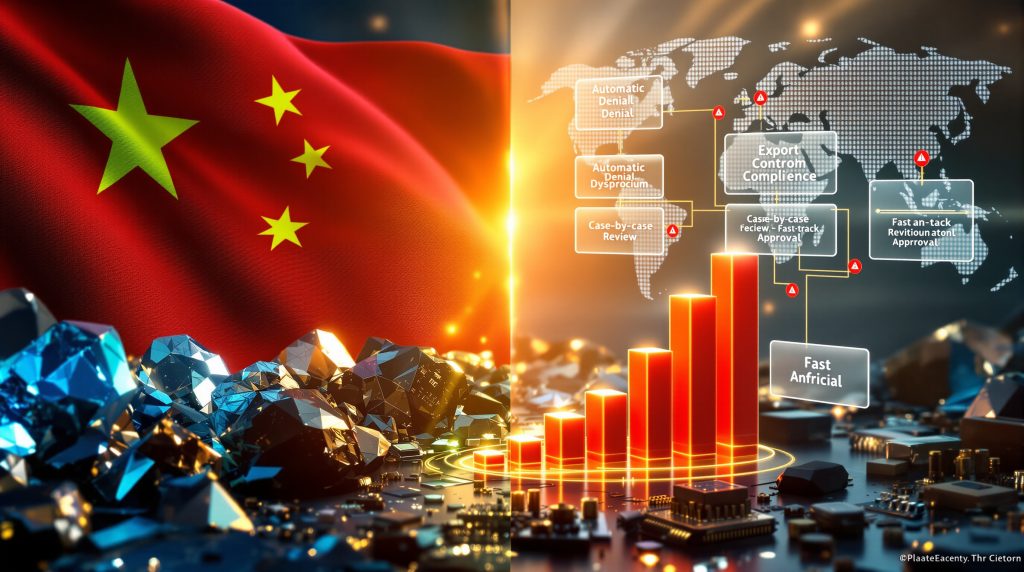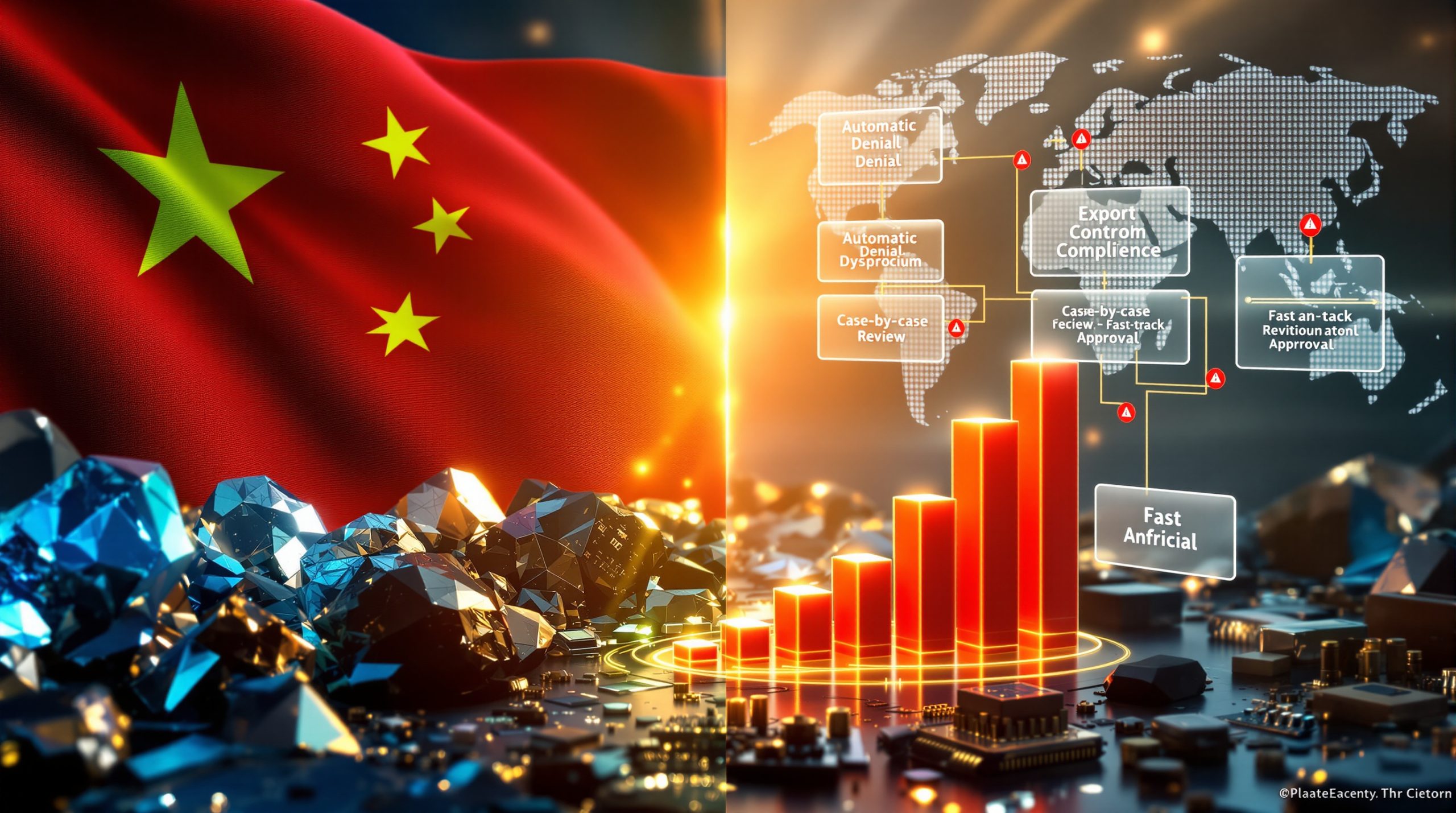China's rare earth export controls represent one of the most significant shifts in global mineral trade policy in over a decade. These new regulations establish a comprehensive framework that fundamentally changes how Chinese-origin rare earth materials reach international markets, particularly affecting companies with defense sector connections. Furthermore, these developments provide crucial rare earth reserves insights into how geopolitical tensions reshape supply chains.
Understanding China's Strategic Export Framework
The validated end-user system creates a tiered approach to rare earth exports that allows Beijing to maintain strategic control while honoring trade commitments. This framework replaces previous blanket restrictions with a sophisticated licensing mechanism that evaluates each potential recipient based on their intended applications and organizational affiliations.
Under this system, Chinese exporters must obtain specific licenses before shipping materials to international buyers. The process involves detailed documentation of end-use purposes, organisational structure, and downstream applications. Companies seeking to import Chinese rare earth materials must demonstrate compliance with the validated end-user requirements, including verification of their business operations and intended material applications.
The licensing system covers both direct rare earth elements and downstream products containing Chinese-origin materials. This comprehensive scope means that manufacturers using even minimal quantities of Chinese rare earth content must navigate the new regulatory requirements.
Critical Materials Under New Controls
The export controls target twelve of seventeen rare earth elements that are essential for modern technology applications. These materials include dysprosium and terbium for permanent magnets, neodymium for electric vehicle motors, and europium for display technologies. The selection reflects China's strategic assessment of which materials provide the greatest leverage over international supply chains.
Beyond raw elements, the controls extend to processed materials, alloys, and manufactured components. This broad coverage ensures that companies cannot circumvent restrictions by sourcing partially processed materials or intermediate products. The de minimis threshold of 0.1% Chinese-origin content creates one of the most comprehensive control mechanisms in international trade.
Rare earth-based magnets face particular scrutiny due to their critical role in defence applications. These permanent magnets are essential components in missile guidance systems, radar equipment, and military communications technology. The controls specifically target these high-performance materials while potentially allowing exports of lower-grade alternatives for civilian applications.
Implementation Timeline and Process
The rollout of China's validated end-user framework follows Beijing's broader strategy of selectively easing export restrictions while maintaining strategic oversight. This approach emerged from trade negotiations that sought to balance commercial relationships with national security imperatives, as highlighted by recent critical minerals energy security analyses.
Current implementation focuses on establishing the administrative infrastructure for license processing and validation. The system requires significant coordination between Chinese export authorities, international buyers, and downstream manufacturers to ensure compliance verification throughout supply chains.
Processing timelines vary significantly based on the validation category and end-user profile. Fast-track approvals for pre-validated civilian manufacturers can occur within days, while comprehensive reviews for new applicants or sensitive applications may extend to several months.
Navigating the Export Licensing System
The validated end-user framework operates through three distinct pathways that determine processing speed and approval likelihood. This tiered structure allows China to differentiate between various types of international buyers while maintaining oversight of sensitive applications.
Companies with established civilian manufacturing operations and no defence sector connections receive preferential treatment through expedited processing channels. These organisations must demonstrate consistent civilian applications and provide ongoing compliance verification to maintain their validated status.
| Control Level | Materials Covered | Review Process | Defence Sector Impact |
|---|---|---|---|
| Automatic Denial | Military applications | No review | Complete restriction |
| Case-by-case | Dual-use technologies | 45-day assessment | Selective approval |
| Fast-track | Vetted civilian firms | Expedited process | No restrictions |
Validation Requirements and Documentation
The application process requires comprehensive documentation of business operations, intended material applications, and downstream supply chain relationships. Companies must provide detailed technical specifications for their manufacturing processes and end-product applications to demonstrate compliance with civilian-use requirements.
Organisational due diligence forms a critical component of the validation process. Chinese authorities examine corporate structures, ownership relationships, and business partnerships to identify potential military connections. Even indirect relationships through joint ventures, research collaborations, or supply agreements can affect validation decisions.
Financial documentation must demonstrate legitimate commercial purposes for rare earth imports. This includes production forecasts, customer contracts, and revenue projections that support requested import volumes. Authorities may request additional financial verification for large-volume applications or new market entrants.
Approval Timelines and Appeal Mechanisms
Standard processing timelines begin upon submission of complete documentation packages. The 45-day assessment period for dual-use applications provides a defined timeline for most commercial applications, though complex cases may require additional review time.
Appeals processes allow companies to contest denial decisions or request reconsideration of validation terms. However, appeals for military-affiliated organisations face systematic denial regardless of civilian application claims. The system prioritises definitive separation between civilian and defence sector access to Chinese rare earth materials.
Ongoing compliance monitoring requires validated users to maintain their civilian status and report any changes in business operations or ownership structure. Violations can result in immediate validation revocation and potential penalties for both Chinese exporters and international buyers.
Industry Impact Analysis Across Key Sectors
Defence contractors face the most severe restrictions under China's new export framework. Any organisation with current or historical military connections encounters automatic licence denial, effectively cutting off access to Chinese rare earth materials for weapons systems and military equipment manufacturing.
The definition of military affiliation extends beyond direct defence contracts to encompass research partnerships with military institutions, supply relationships to defence integrators, and participation in government security programs. This broad interpretation creates cascading effects throughout defence supply chains, affecting both prime contractors and sub-tier suppliers.
Electric Vehicle Manufacturing Challenges
Electric vehicle manufacturers face complex navigation requirements due to the dual-use nature of rare earth applications in automotive technology. Permanent magnets in EV motors require specific rare earth elements that are also used in military applications, creating overlap between civilian and restricted categories.
Battery technology development relies heavily on rare earth elements for cathode materials and electronic control systems. China rare earth export controls could significantly impact EV battery production costs and performance characteristics, particularly for high-performance applications requiring specialised rare earth compounds.
Supply chain transparency becomes critical for EV manufacturers seeking to maintain access to Chinese rare earth materials. Companies must demonstrate clear separation between civilian automotive applications and any potential defence sector relationships or dual-use technology development.
Semiconductor Industry Implications
Semiconductor manufacturing requires trace amounts of rare earth elements for specialised production processes, despite the small quantities involved. The 0.1% de minimis threshold means that virtually all semiconductor facilities using Chinese-origin materials must comply with the validated end-user requirements.
Advanced chip manufacturing for military or aerospace applications faces particular scrutiny under the dual-use category. Companies producing semiconductors for both civilian and defence applications must segregate their production lines and demonstrate clear end-use differentiation to maintain Chinese material access.
Processing equipment and manufacturing tools that contain rare earth components also fall under the export controls. This creates additional complexity for semiconductor manufacturers who must verify the origin and content of all production equipment and materials.
Consumer Electronics and Technology
Consumer electronics manufacturers generally receive more favourable treatment under the validated end-user system, provided they maintain clear civilian applications and avoid military sector relationships. However, the broad scope of rare earth applications in modern electronics creates comprehensive coverage requirements.
Display technologies, audio equipment, and mobile devices all incorporate rare earth elements in various components. Manufacturers must document the specific applications and demonstrate that their products serve exclusively civilian markets to qualify for expedited processing.
"Companies with any military affiliations face automatic licence denials, while civilian manufacturers must navigate complex compliance requirements for products containing as little as 0.1% Chinese-origin materials."
Strategic Motivations Behind the Export Controls
China's implementation of rare earth export controls reflects a sophisticated geopolitical strategy that balances economic engagement with strategic competition. The timing follows resolution of broader trade tensions while establishing new mechanisms for selective technology access control, coinciding with the US-China trade war impact on global supply chains.
The validated end-user framework allows Beijing to maintain commercial relationships with allied nations while restricting technology advancement in strategic competitor nations. This differentiated approach provides greater flexibility than blanket export bans while achieving similar strategic objectives.
National security considerations drive the comprehensive scope of the controls, particularly regarding defence applications. Chinese policymakers view rare earth dominance as a strategic asset that requires careful management to prevent technology advantages from flowing to potential adversaries.
Economic Leverage and Trade Positioning
The export control system provides China with significant leverage in international trade negotiations. By controlling access to critical materials, Beijing can influence the behaviour of foreign governments and corporations without resorting to broader economic sanctions or trade restrictions.
Revenue maintenance from civilian exports allows China to preserve economic benefits while achieving strategic objectives. The selective nature of restrictions means that commercial relationships with compliant partners continue uninterrupted, maintaining Chinese market share in global rare earth supply.
Market stability considerations influenced the design of the graduated control system. Rather than creating immediate supply disruptions through blanket bans, the validated end-user approach allows for managed transition periods and selective enforcement based on strategic priorities.
Response to International Technology Competition
The export controls represent China's response to increasing international competition in advanced technology sectors. By limiting rare earth access for military applications, Beijing seeks to slow foreign technology development while maintaining Chinese advantages in critical industries.
Supply chain weaponisation through rare earth controls demonstrates China's willingness to use economic tools for strategic purposes. This approach allows for precise targeting of specific sectors and applications while maintaining broader commercial relationships.
Long-term strategic positioning motivates the comprehensive nature of the controls. Chinese policymakers appear focused on maintaining technological leadership through sustained control over critical material access rather than seeking short-term economic gains.
Global Supply Chain Restructuring
International supply chains face fundamental restructuring as companies adapt to China's new export control regime. Organisations must develop alternative sourcing strategies, accumulate strategic inventories, and invest in substitution technology development to maintain operational continuity.
Price volatility across rare earth markets has increased significantly as buyers seek to secure alternative supplies and build inventory buffers. Premium pricing for non-Chinese rare earth sources reflects both supply constraints and increased demand from companies seeking to reduce dependency on Chinese materials.
Geographic diversification of rare earth processing and manufacturing becomes essential for companies seeking supply security. This shift requires significant capital investment in new facilities, technology transfer to alternative locations, and development of regional supply chain networks.
Alternative Sourcing Development
Mining operations outside China are experiencing renewed investment interest as companies seek to establish alternative rare earth sources. Projects in Australia, Canada, and Vietnam are receiving increased funding and development priority to create non-Chinese supply options.
Processing capacity development represents a critical bottleneck in alternative sourcing strategies. While rare earth deposits exist globally, the specialised processing required to create usable materials remains concentrated in China, necessitating significant infrastructure investment in other regions.
Supply contract dynamics are shifting toward longer-term agreements with non-Chinese suppliers, even at premium pricing. Companies are prioritising supply security over cost optimisation as they recognise the strategic risks associated with single-source dependency.
Manufacturing Cost Implications
Total cost of ownership analysis reveals significant increases for companies transitioning to alternative rare earth sources. Higher material costs, transportation expenses, and quality verification requirements contribute to elevated production costs across affected industries.
Substitution material research is accelerating as companies seek to reduce their dependence on rare earth elements entirely. While complete substitution remains challenging for many applications, incremental improvements in alternative materials can reduce rare earth content requirements.
Inventory management strategies are evolving to include strategic stockpiling of critical materials. Companies are balancing carrying costs against supply security benefits, often accepting higher inventory costs to ensure operational continuity.
International Response Strategies
Congressional action in the United States focuses on reducing strategic vulnerability through domestic production capacity development and supply chain diversification initiatives. Bipartisan support exists for legislation addressing China's market dominance in critical minerals and the national security implications of import dependency.
The House Select Committee on China has documented China's use of mineral market dominance as an economic tool for geopolitical influence. Their recommendations include enhanced oversight of commodity trading platforms and support for domestic mining operations to reduce foreign dependency.
Price control mechanisms and market oversight expansion represent potential legislative responses to Chinese market manipulation concerns. However, implementation challenges exist regarding market intervention in globally traded commodities and coordination with international partners.
European Union Diversification Initiatives
European buyers are accelerating procurement from non-Chinese sources to reduce exposure to export control risks. The European Union's strategic autonomy initiatives include increased investment in domestic processing capacity and partnerships with allied mining jurisdictions.
Critical raw materials legislation in the European Union establishes frameworks for supply chain resilience and strategic stockpiling. These policies recognise rare earth dependency as a strategic vulnerability requiring systematic address through industrial policy coordination.
Carbon border adjustment mechanisms may inadvertently support non-Chinese rare earth suppliers by creating cost advantages for operations with lower carbon footprints. This could provide additional incentives for supply chain diversification beyond pure security considerations.
North American Supply Chain Integration
Canadian and American cooperation on critical minerals reflects shared recognition of supply chain vulnerabilities. Joint funding for projects like Fortune Minerals' cobalt, gold, bismuth, and copper operations in the Northwest Territories demonstrates coordinated approach to alternative capacity development.
The U.S. Department of Defence's investment in civilian mining operations indicates military recognition of supply chain risks. Strategic materials stockpiling and domestic production incentives represent policy tools for reducing foreign dependency in defence applications.
Cross-border integration of North American rare earth supply chains could provide regional alternatives to Chinese sources. However, significant infrastructure investment and technology transfer are required to establish competitive processing capabilities.
Investment Implications and Market Opportunities
Rare earth mining companies outside China are experiencing increased investor interest and valuation premiums as the strategic value of alternative sources becomes apparent. Companies with proven reserves and processing capabilities command particular attention from both private and strategic investors.
Technology sector vulnerability to supply disruptions creates investment opportunities in companies developing substitution materials and alternative supply chains. Venture capital funding for battery technology, permanent magnet alternatives, and recycling processes has increased substantially.
Supply chain transparency and geographic diversification have become competitive advantages in technology manufacturing. Companies demonstrating reduced Chinese dependency may command valuation premiums due to their lower regulatory and supply chain risks.
Mining Sector Investment Trends
Junior mining companies with rare earth projects are receiving increased funding attention as investors recognise the strategic value of alternative supply sources. However, the long development timelines and significant capital requirements for rare earth projects create challenges for smaller operators seeking to capitalise on market opportunities.
Established mining companies are reallocating capital toward rare earth operations and acquisitions. The strategic value of these materials has elevated them from specialty commodities to critical national security assets, justifying premium investment returns.
Government funding support for domestic rare earth operations reduces investment risks while providing development capital. Public-private partnerships are becoming common structures for advancing strategic mining projects that serve both commercial and national security objectives.
Technology Sector Adaptation
Research and development investment in rare earth substitution technologies is accelerating across multiple industries. Companies are prioritising material science research to reduce dependency on restricted materials while maintaining performance characteristics.
Vertical integration strategies are emerging as companies seek greater control over their supply chains. Technology manufacturers are investing directly in mining operations and processing facilities to ensure continued material access despite export restrictions.
Recycling technology development presents significant opportunities for recovering rare earth elements from end-of-life products. Urban mining approaches could provide substantial alternative sources of materials while addressing environmental concerns about traditional mining operations.
Corporate Compliance and Risk Management
Supply chain auditing has become essential for companies seeking to maintain access to Chinese rare earth materials under the validated end-user system. Organisations must implement comprehensive tracking systems to verify material origins and demonstrate compliance with civilian-use requirements.
Risk assessment frameworks must incorporate geopolitical factors alongside traditional business considerations. Companies are developing scenario planning for various levels of export restriction and building flexibility into their operations to adapt to changing regulatory environments.
Legal compliance requires specialised expertise in international trade law and export control regulations. Companies are investing in legal and compliance infrastructure to navigate the complex requirements of the validated end-user system.
Supply Chain Transparency Initiatives
Blockchain technology and digital tracking systems are being implemented to provide verifiable documentation of material origins and processing history. These systems help companies demonstrate compliance with export control requirements while improving overall supply chain visibility.
Supplier qualification processes now include comprehensive evaluation of export control compliance capabilities. Companies are requiring their suppliers to implement tracking systems and provide detailed documentation of material sources and processing methods.
Third-party verification services are emerging to help companies validate their supply chain compliance. Independent auditing and certification can provide additional assurance to Chinese exporters and regulatory authorities regarding civilian end-use applications.
Alternative Material Development
Material substitution research is focusing on reducing rare earth content in critical applications while maintaining performance standards. Incremental improvements in alternative materials can significantly reduce exposure to supply chain disruptions without requiring complete technology redesigns.
Collaborative research initiatives between companies and academic institutions are accelerating substitution technology development. Shared research costs and expertise can speed development timelines while spreading investment risks across multiple participants.
Performance trade-offs in alternative materials must be carefully evaluated against supply chain security benefits. Some applications may accept reduced performance characteristics in exchange for supply chain reliability and cost predictability.
Future Outlook and Strategic Implications
Expansion of export controls to additional materials and applications appears likely as China refines its strategic approach to supply chain leverage. The success of the rare earth framework may encourage similar controls on other critical materials including lithium, cobalt, and specialised metals, as evidenced by recent Chinese control measures.
Bilateral trade agreements may increasingly include provisions addressing critical material access and supply chain security. Countries are recognising that traditional trade frameworks inadequately address the strategic dimensions of mineral supply relationships.
Technology development timelines will increasingly influence geopolitical competition as nations seek to reduce dependency on foreign-controlled supply chains. The pace of alternative technology development may determine the effectiveness of export control strategies.
Long-term Market Restructuring
Permanent changes in global rare earth supply chains appear likely as companies invest in alternative sources and processing capabilities. Even if China rare earth export controls are eventually relaxed, the strategic vulnerabilities exposed by current restrictions will continue to influence corporate planning and government policy.
Regional supply chain clusters may emerge as countries coordinate their critical materials policies and investment strategies. North American, European, and Indo-Pacific regional approaches could create alternative trading blocs for strategic materials.
Innovation acceleration in both substitution technologies and alternative supply sources will continue driven by strategic necessity rather than purely economic considerations. This may lead to breakthrough technologies that fundamentally alter demand patterns for current rare earth applications.
Strategic Planning Considerations
Companies must develop flexible strategies that can adapt to changing export control regimes and geopolitical conditions. Scenario planning should include various levels of restriction and different approaches to international coordination on critical materials access.
Investment decisions increasingly require evaluation of geopolitical risk alongside traditional financial metrics. Supply chain security and regulatory compliance costs must be incorporated into long-term planning and capital allocation decisions.
Stakeholder engagement with government officials and industry associations becomes more important as private sector operations intersect with national security considerations. Companies must balance commercial objectives with broader strategic national interests.
Furthermore, the implementation of the exec order on critical minerals will likely influence how international businesses navigate these new restrictions. Additionally, countries like Australia are responding by developing their Australian critical minerals reserve to reduce global dependency on Chinese supplies.
The transformation of rare earth trade through China rare earth export controls represents a fundamental shift in how strategic materials move through global supply chains. Organisations across all affected sectors must adapt their strategies, investments, and operations to navigate this new regulatory environment while maintaining competitive advantage and operational continuity. The long-term implications extend far beyond immediate supply chain adjustments to encompass broader questions of technological development, international trade relationships, and strategic competition in critical industries.
Looking for Opportunities in Critical Minerals?
Discovery Alert's proprietary Discovery IQ model delivers instant alerts on significant mineral discoveries across the ASX, including strategic materials affected by shifting global supply chains. With historic discoveries demonstrating the potential for substantial returns in critical minerals sectors, subscribers gain immediate access to actionable opportunities as supply chain dynamics create new investment possibilities. Begin your 30-day free trial today to position yourself ahead of evolving market conditions.




